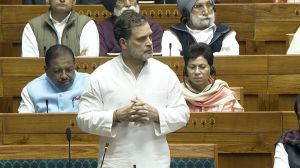Follow Pak example, cut down
The Pakistan Army is Pakistan, so say Indian analysts. The future of Pakistan and the future of the Pakistani Army are indistinguishable, th...

The Pakistan Army is Pakistan, so say Indian analysts. The future of Pakistan and the future of the Pakistani Army are indistinguishable, they reiterate. Pakistan is under the constant threat of Indian conventional superiority, say the Pakistanis. That is why they need a nuclear capability, add the Pakistani strategists, to match larger Indian numbers.
So the last idea one would expect from Islamabad is one of troop reductions. Yet we have an offer of a 50,000-man cut in the Pakistan Army. We obviously have to take it seriously, and the first question—with new Foreign Minster Natwar Singh scheduled to visit Pakistan soon—is, are we at the beginning of a Mutual Balanced Force Reduction process?
If so, the negotiations and, more importantly, the verification procedures are a long road, for which neither the Army nor the foreign office is adequately equipped. The same process in Europe took 15 and a half years.
Admittedly, the circumstances in Pakistan are not similar to those in India. There are wide economic disparities, Pakistan is overspending its hard-earned taxes, and the Indian defence budget has fallen to below 3 per cent. But Indian paramilitary forces have been unable to go on the offensive in J-K, the Home Ministry is unable to reform the central police forces to make them perform under combat conditions. The Army has had to raise the Rashtriya Rifles, whose strength is due to go up by another 10 battalions to 65. So how can the Indians offer a matching reduction?
The answer is that both the Indian and Pakistan armies are likely to become much more efficient if their numbers are reduced. Consider the facts, which are common to both armies. The Indian army spends about Rs 380 billion a year, of which 70 per cent goes in purely maintaining the Army, that is, salaries, fuel, provisions, uniforms and rations. What is left, amounting to Rs 114 billion, is spent on modernising hardware. Almost four-fifths of this sum is committed to purchases made in previous years. The remaining amount, equivalent of half a billion dollars, is actually available for modernisation.
It is no wonder that army personnel have to live in mud structures on the border, run their trucks on potholed roads, do without adequate signals and electronic-warfare equipment, run a communications system on antiquated satellite transponders, manage a backlog of 1,000 tanks yet to be modernised, and run an aviation corps smaller than that owned by many private companies abroad. What is eating up all the money in the armies of India and Pakistan is the huge number of uniformed people, hired at a time when soldiers didn’t cost much.
In opportunity costs, a South Asian battalion of infantry (approximately 1,000 men) would cost anything up to Rs 6 crore a year in salaries, with another Rs 4 crore in maintenance costs. A 50,000-man reduction in troop strength would reduce the Army’s annual maintenance costs by Rs 500 crore. This is big money considering that a dedicated satellite to run the Army’s communications would cost only Rs 300 crore—or that money saved could give the Army its own six-squadron combat and special operations helicopter force in five years, making it the second most modern rapid reaction force in the world after the US.
The huge manpower costs of both armies cripple their modernisation and eventually also cripple their strategy. Manpower is used in the only way possible, which is to string them along the border, since their poor mobility precludes stationing them in the rear areas. The continued deployment of combat troops on the border provokes incidents, by their very presence, unrelated to any political dispute. Reducing troop strength is therefore beneficial to both India and Pakistan, but Islamabad deserves all credit for a measure which, if implemented, could start both countries off on a long and beneficial journey.
Alternatively, the Indians can make a counter-offer that will go a long way in stabilising the nuclear scenario. Both India and Pakistan have a hardcore deterrent capability on which neither side will compromise. This is understandable. But what is truly frightening is that both sides have a surplus of short-range, low-technology missiles that vastly outnumber the nuclear weapons stocks of either country.
These missiles were ordered by the short-sighted South Asian leaderships and military hierarchies in the late ’80s and early ’90s, from compliant technical bureaucracies, who saw easy money to be made on the deal. These missiles, the Indian Prithvi and the Pakistani Hatf 1, 2, 2A and 3, which balance each other in numbers, are nothing more than exorbitantly expensive long-range artillery.
In the meanwhile, their main importance lies in thoroughly confusing the opposite side on what and where the nuclear deterrent is situated. This confusion, which is dangerous, leads to misperception and the possible use of nuclear weapons in a crisis. They need to go, and getting rid of these ridiculous missiles will do much to convince the world that South Asian leaderships have the maturity to own and manage nuclear weapons.
India, as the bigger country, with bigger conventional forces, can hardly ignore the Pakistani offer without damaging its credibility in the world—no matter what the Indian ‘‘patriots’’ might say. As the bigger country going in for nuclear CBM talks with Pakistan, it would be a statesmanlike step to accept the Pakistani offer in principle, leaving it to the two armies to work out the mechanics of a manpower reversal scheme. At the same time, the Indian leadership should offer a move to ban and progressively dismantle the conventional warhead missiles in a process involving technical experts under the Defence Ministry. It was, after all, India’s point that the nuclear CBM discussion could not wait for the Kashmir issue to be resolved, a point on which General Musharraf seemed oblivious at Agra.
We are now about to embark on the first of these momentous talks with Pakistan. So, now that a new government is in place in New Delhi, one hopes to see adequate preparations made before the negotiations.
- 01
- 02
- 03
- 04
- 05































